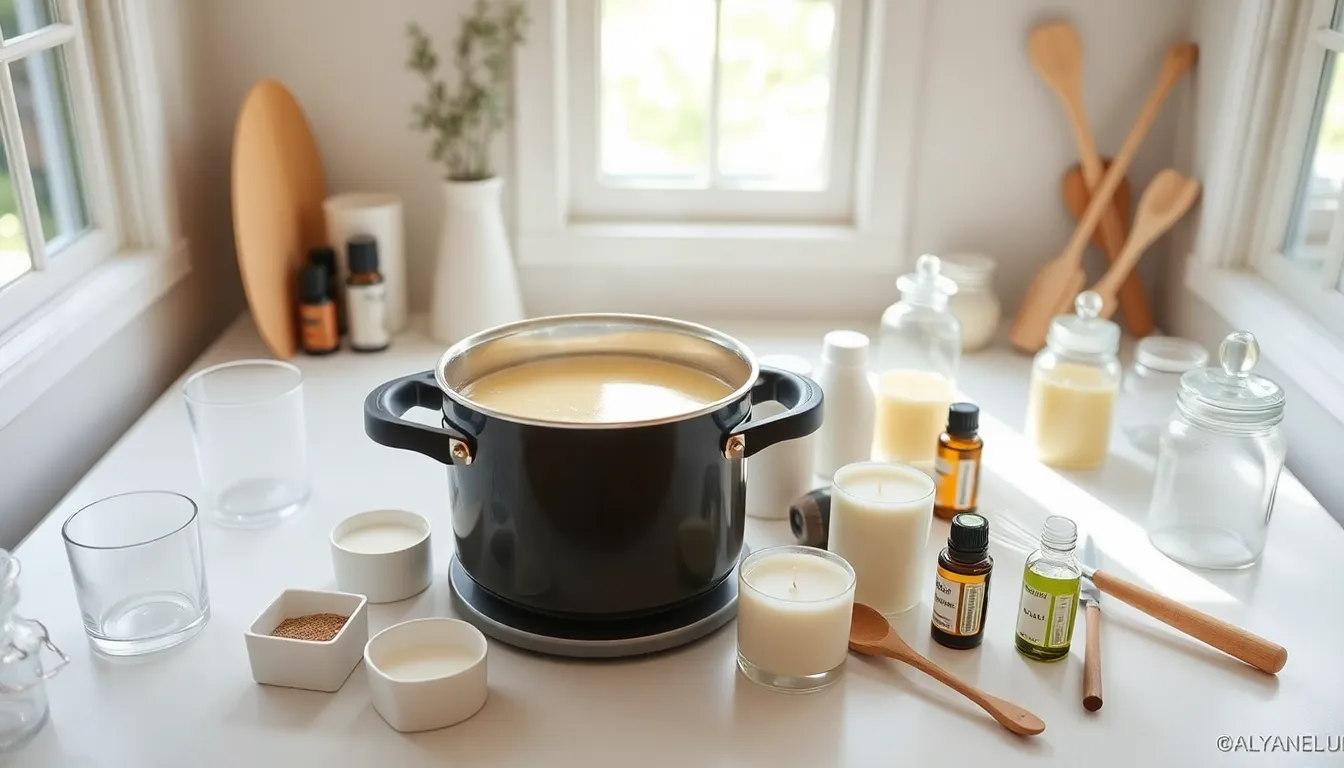Imagine walking into a room that smells like a cozy bakery or a tranquil spa. Scented candles have a magical way of transforming any space into a haven. But why settle for store-bought when you can unleash your inner artisan and craft your own delightful creations at home?
Table of Contents
ToggleMaterials Needed
Creating scented candles at home requires a few essential materials for a successful project. Gather these items before starting the candle-making journey.
Wax Types
Several types of wax are suitable for candle making. Paraffin wax remains popular due to its affordability and ease of use. Soy wax offers a natural alternative, providing a clean burn and excellent scent throw. Beeswax boasts a longer burn time and a natural honey aroma that complements fragrances. Palm wax provides a unique crystalline effect, ideal for decorative candles. Each wax type affects the burn quality and scent diffusion.
Fragrance Oils
Choosing the right fragrance oils is crucial for creating delightful scents. Essential oils offer natural aromas from plants, perfect for those seeking organic options. Synthetic fragrance oils provide a broader range of scents and often have better stability in candles. Consider using high-quality oils for a more vibrant fragrance. Mixing fragrance oils can create custom scents tailored to personal preferences, enhancing the candle experience.
Wicks and Containers
Selecting wicks and containers influences the candle’s performance. Cotton wicks work well with various wax types and provide a steady flame. Wooden wicks create a unique crackling sound and add charm to the ambiance. Containers, ranging from glass jars to metal tins, help shape the candles and add aesthetic appeal. Ensure the container can withstand heat and is appropriate for the chosen wax and wick combination.
Preparation Steps

Preparation steps are essential for creating scented candles at home. This guide provides clear instructions to ensure a smooth process.
Setting Up Your Workspace
Establish a dedicated workspace for candle making. Clear the area of unnecessary items to prevent accidents. Gather all necessary materials such as wax, wicks, fragrance oils, and containers. Ensure ventilation to manage any fumes from melting wax. Protect surfaces with newspaper or craft paper for easy cleanup.
Melting the Wax
Choose your preferred wax type for melting. Use a double boiler for gentle melting, preventing direct heat exposure. Measure the desired amount of wax, typically one pound, then place it in the boiler. Monitor the temperature, aiming for about 170°F to 180°F, ensuring the wax completely melts. Stir occasionally to promote even melting and check for any unmelted chunks.
Adding Fragrance
Select your favorite fragrance oil to enhance your candles. Add fragrance oil at a ratio of 1 ounce per pound of wax for optimal scent strength. Pour the fragrance into the melted wax and stir thoroughly for even distribution. Allow the wax to cool slightly before pouring it into containers, ensuring the fragrance binds well. Confirm the temperature is ideal for pouring to prevent issues with scent retention.
Pouring the Candles
Pouring candles requires attention to detail to ensure a successful result. It’s essential to prepare the containers properly and employ effective pouring techniques for the best outcome.
Preparing the Containers
Clean containers thoroughly before use to prevent contaminants from impacting the candle. Choose heat-resistant materials like glass or metal for safety. Center the wick in each container using a wick holder or a dab of melted wax, ensuring it remains straight during the pouring process. Wicks should not touch the sides or bottom to achieve even burning.
Pouring Techniques
Pour with care to avoid air bubbles. Maintain a steady hand and pour the wax slowly into the containers once it reaches about 140-160°F. Pouring from a height of a few inches reduces the chance of bubbles forming. Leave some space at the top, about half an inch, to avoid spillage. Allow the candles to cool undisturbed for 4-6 hours, ensuring a smooth surface once fully set.
Cooling and Finishing Touches
Cooling is essential for achieving a refined appearance in scented candles. Candles need to cool undisturbed for 4-6 hours. A stable environment prevents imperfections. Ambient temperature should be consistent, ideally around 70°F.
Allowing Candles to Cool
Once the candles are poured, patience is key. Cooling happens naturally as the wax solidifies. It’s important to keep the candles in a dry, draft-free area. A gentle breeze might cause uneven surfaces or cracks. Inspecting the candles after cooling can reveal any surface imperfections.
Trimming Wicks and Labeling
After the candles cool, trimming wicks enhances their performance. Wicks should be cut to about 1/4 inch above the wax surface. This length helps promote a steady flame and prevents excessive soot. Labeling candles adds a personal touch, providing fragrance details and any usage instructions. Consider using decorative labels to create an appealing presentation.
Safety Tips
Safety is crucial when making scented candles at home. Proper precautions prevent accidents and ensure a pleasant crafting experience.
Handling Hot Wax
Avoid burns by using protective gear. Wearing gloves and long sleeves minimizes the risk of contact. Heat wax in a double boiler to control temperature effectively. Monitor the wax closely, maintaining a temperature between 170°F and 190°F. If it begins to smoke, remove it from heat immediately. Always use a sturdy, heat-resistant container for melting. Keep distractions at bay to focus on the task at hand. Properly dispose of any wax spills promptly to maintain a safe workspace.
Using Fragrance Safely
When selecting fragrance oils, prioritize quality and safety. Choose certified skin-safe fragrance oils to minimize allergic reactions. Add fragrance oils only after melting the wax. Mixing them at the right ratio is essential for scent strength. Avoid using more than 10% fragrance oil to prevent excessive smoking during burning. Conduct a patch test if unsure about skin sensitivity. Store fragrance oils out of reach of children and pets to ensure safety. Securely close containers after each use to maintain potency and prevent spills.
Making scented candles at home is a rewarding and enjoyable craft. It allows individuals to personalize their space with unique fragrances while showcasing creativity. By selecting the right materials and following the outlined steps, anyone can create beautiful candles that enhance the ambiance of their home.
With attention to detail during the pouring and cooling processes, the final product can be both visually appealing and aromatic. Safety is paramount throughout the candle-making journey, ensuring a pleasant experience without mishaps.
Whether for personal use or as thoughtful gifts, homemade scented candles offer a delightful way to brighten up any environment. So grab the materials and start crafting those candles today.




